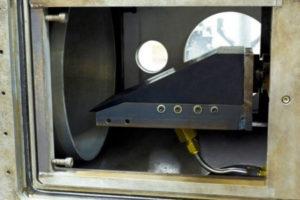 Military research, analysis and commentary company Defence IQ revealed in a recent study presented via infographic that over 28% of surveyed military professionals and stakeholders are actively looking into the development and implementation of 3D printing or additive manufacturing-based systems.
Military research, analysis and commentary company Defence IQ revealed in a recent study presented via infographic that over 28% of surveyed military professionals and stakeholders are actively looking into the development and implementation of 3D printing or additive manufacturing-based systems.
Previously, 3DPrint.com reported the increasing usage of 3D printing technology in the field of military defense, aircraft and spacecraft manufacturing. We have previously taken a look at how Oxford Performance Materials (OPM) will play a vital role in the development of Boeing’s spacecraft CST-100 Starliner by replacing the majority of components within the crew capsule with lightweight and robust 3D printed parts. Lawrence Varholak, President of OPM Aerospace & Industrial, emphasized the efficiency of using 3D printing technology in manufacturing processes, stating that 3D printed materials or components are significantly easier and faster to produce.
 Prior to OPM’s partnership with Boeing, 3DPrint.com also covered the active involvement of military agencies and air force such as the Brazilian Air Force in the integration of 3D printing technology into traditional manufacturing methods, as well as many other military applications around the world that can benefit from additive manufacturing.
Prior to OPM’s partnership with Boeing, 3DPrint.com also covered the active involvement of military agencies and air force such as the Brazilian Air Force in the integration of 3D printing technology into traditional manufacturing methods, as well as many other military applications around the world that can benefit from additive manufacturing.
According to the study from Defence IQ and its reported labeled “Additive Manufacturing: On the Cusp of an Aerospace, Defence and Space Revolution,” the global defense, aerospace and spacecraft industry are similarly observing the rapid increase in demand for 3D printing technology. A growing number of executives, government officials, defense specialists and aircraft designers are shifting towards 3D printing technology to deal with each step of development beginning with prototype development to distribution. Defence IQ states:
“Since the first patents were filed for the stereolithography process in 1984, additive manufacturing (AM) has had the potential to revolutionise global business. The advance of technology in the past three decades has led to some calling the rise of 3D printing ‘the third industrial revolution’. In the aerospace, defence and space sectors, additive manufacturing is primed to streamline supply chains, better manage material inputs and process challenges and help tailor product strategies. We went to our community of additive manufacturing professionals to find out what the present and future hold for the applications of this cutting-edge technology.”
The study of Defence IQ surveyed and interviewed military and defense industry professionals and leaders to better understand the demand for 3D printing technology. Researchers at the company also evaluated long-term plans of companies within military and defense markets to see whether 3D printing technology is embedded on their roadmap.
 Defence IQ researchers discovered that 46% of the stakeholders and industry leaders within military and defense industries are “extremely” or “very” aware of the benefits and advantages of using additive manufacturing. In addition to that, 75% of the study’s respondents stated that 3D printing technology will be established as the base protocol or technology to guide manufacturing processes within the next 10 years.
Defence IQ researchers discovered that 46% of the stakeholders and industry leaders within military and defense industries are “extremely” or “very” aware of the benefits and advantages of using additive manufacturing. In addition to that, 75% of the study’s respondents stated that 3D printing technology will be established as the base protocol or technology to guide manufacturing processes within the next 10 years.
Even the professionals in the field of defense who didn’t have a thorough understanding of the benefits of 3D printing technology believed that the technology is essential for the market, especially to enhance or optimize manufacturing processes.
In fact, 28% of the professionals thought that manufacturing was the biggest challenge within the two industries and the other 16% stated that design or prototype development was the second most vital issue industry leaders must focus on. Among the three studied sectors, respondents found aerospace to be the most likely domain where “additive manufacturing [will provide] the most benefit over the next five years,” with defense and space applications trailing the vote.
This study was released ahead of next month’s Additive Manufacturing for Aerospace, Defence & Space conference, to be held in London on February 21-23. The full infographic can be downloaded here. Discuss in the Defence IQ forum at 3DPB.com.
[Images Via: Defence IQ]Subscribe to Our Email Newsletter
Stay up-to-date on all the latest news from the 3D printing industry and receive information and offers from third party vendors.
You May Also Like
Nylon 3D Printed Parts Made More Functional with Coatings & Colors
Parts 3D printed from polyamide (PA, Nylon) 12 using powder bed fusion (PBF) are a mainstay in the additive manufacturing (AM) industry. While post-finishing processes have improved the porosity of...
3DPOD Episode 193: Flow and What’s Possible in 3D Printing with Ricky Wildman, University of Nottingham
Ricky Wildman is working on 3D printing pills, but, as Professor of Multiphase Flow and Physics at Nottingham, he does a whole lot more. His research encompasses the characterization of...
3D Printing Webinar and Event Roundup: March 17, 2024
It’s another busy week of webinars and events, including SALMED 2024 and AM Forum in Berlin. Stratasys continues its in-person training and is offering two webinars, ASTM is holding a...
3D Printed Micro Antenna is 15% Smaller and 6X Lighter
Horizon Microtechnologies has achieved success in creating a high-frequency D-Band horn antenna through micro 3D printing. However, this achievement did not rely solely on 3D printing; it involved a combination...






























